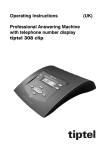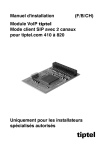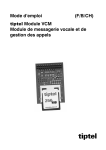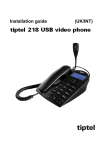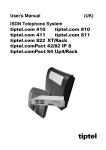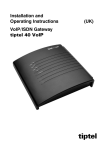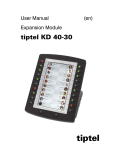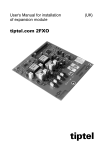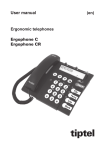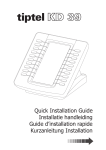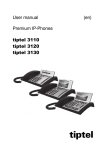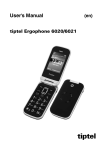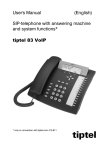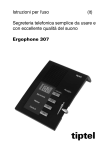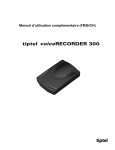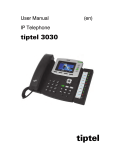Download English - Tiptel
Transcript
User's Manual (UK) tiptel VCM Module Voicemail / Call Management Module tiptel Table of Contents Table of Contents Table of Contents .............................................................................................. 3 Notes .................................................................................................................. 4 Directions for the operation of the telephone system ................................................ 4 Configuration ..................................................................................................... 5 Subscriber configuration via PC.................................................................................. 5 Answering machine ..................................................................................................... 7 Day/night switching ................................................................................................ 7 Settings: Answering machine................................................................................. 7 Transfer messages ................................................................................................. 8 Remote access setting ........................................................................................... 8 Message forwarding ............................................................................................... 10 ICM ............................................................................................................................... 12 Remote access .................................................................................................. 13 Remote access............................................................................................................. 13 Remote access functions ............................................................................................ 14 Playback incoming message function ................................................................... 14 Switching functions................................................................................................. 14 Changing outgoing messages............................................................................... 15 Message transfer function ...................................................................................... 15 Switch off device function....................................................................................... 15 Remote activation of answering mode....................................................................... 16 Index................................................................................................................... 17 3 Notes Notes We reserve the right to make changes to this User's Manual or the hardware described at any time and without prior notice. The current version of the User's Manual is also available as a pdf file on the Internet at www.tiptel.com. The texts and illustrations of this user's manual have been compiled with the utmost care, however, errors cannot be ruled out completely. The publisher can not be held liable for any incorrect information or consequences arising from them. © 2007 Tiptel .com GmbH Business Solutions Ratingen. All rights reserved. Directions for the operation of the telephone system Before accessing the VCM module 14 for the first time you should become familiar with the following symbols. In the User's Manual, the following symbols are used for programming the system or activating and deactivating features: Pick up receiver ...... Enter code digits and key sequences .. Enter special keys R key: Flash function Hang up receiver Notes 4 Configuration Configuration Subscriber configuration via PC Note: Contact the administrator/telephone system installer for information on user name and password, and (if applicable) on a different IP address. It is possible to configure the subscriber’s settings via the PC. In order to do so, you need a PC with network access to your telephones system, your user name and your password. To perform the configuration, start your Internet browser and enter the telephone system’s IP address or the network identifier in the address bar. The factory settings are "192.168.34.100" or "192.168.1.100". 5 Configuration The configuration in the delivery status (factory settings) is described below. Example: Subscriber "Analogue50" wishes to edit his/her configuration. The user name is preset to "Analogue50". No password is used. After logging on, the following web page will be displayed: 6 Configuration Answering machine If your administrator has set up an answering machine for you, you can configure it here. Day/night switching Your telephone system has 6 different configuration profiles. These profiles are set up by the administrator and used to switch individual subscribers. You can switch between the individual profiles here. Switching can be performed automatically via the time control. Settings: Answering machine Standby You switch your personal answering machine ON or OFF here. 7 Configuration Language selection Select the language for voice output on your answering machine here. Voice output is required for the following functions: • • • For fixed default message For remote access message For message forwarding voice message Memory allocation This indicates the free recording capacity Select message Select your personal message here. Refer to “Transfer messages” in this chapter on how to transfer the message. Switch on delay Enter the time until the calls are answered here. Maximum recording length Enter the maximum recording length here. At the end of the recording the answering machine plays back the final message and then switches off. Transfer messages Save / delete message Save your message as a “WAV” file on your PC. Delete your message from the telephone system here. Message name Enter a name for your personal message here. This message You set here whether the message is simply to be played back or whether the caller can leave a message, too. Remote access setting You can also configure or listen to your answering machine via a telephone. The control is via a DTMF-enabled telephone. You enter remote access if the following conditions are met: • You call from an external location and the outgoing MSN of your telephone is identical to the QRC number on your answering machine. 8 Configuration • You have activated the “remote access via 930” function. An internal call on 930 goes directly to the remote access. The answering machine is selected by the caller’s outgoing MSN (subscriber 50 calls the 930 => subscriber 50's answering machine moves to remote access). • In the configuration you have activated remote access and entered a remote access code. After a call you can now enter the remote access code during the OGM to enter remote access mode. Quick Remote Control (QRC) The QRC (quick remote access) number allows you remote access externally without having to enter the remote access code. For example, if you have entered your mobile phone number and call the answering machine from your mobile, you are recognized as being authorized for remote access and can start up remote access without entering the remote access code. It is not possible to enter an internal subscriber call number. Remote access via 930 Set here whether you want to call your personal answering machine directly from your internal telephone by dialling the internal call number 930. Remote access code A 4-digit PIN code has to be entered here. This is used for identification when remote access if switched on. Remote control Set here whether you want to permit remote access. Remote switching on You specify here whether remote activation of telephone answering should be possible. For the “Yes” setting, the answering machine answers a call after 50 seconds even if telephone answering is switched off and waits for a remote access code to be entered. This is how to activate telephone answering remotely. Note: The answering machine now rings in parallel to the subscriber. A caller then receives a dial tone although the subscriber is busy and call waiting has been deactivated. The “call forwarding on busy” setting is therefore not carried out. Remote deletion Set here whether you want to permit remote message deletion. 9 Configuration Message forwarding Message forwarding provides you with the option to be notified on received messages automatically. Message forwarding Switch forwarding for messages received ON or OFF here. Message forwarding by Set the type of forwarding here. The following options are available: • SMS After receiving a voice recording, an SMS is sent automatically. The administrator must have previously configured the SMS function. • Call After receiving a voice recording a specified destination is dialled automatically. As soon as a dial tone is recognised the answering machine hangs up. If the target call number is busy the dialing is repeated three times at 3 minute intervals. The other terminal now detects that there is a voice message via the CLIP information in the call list. • Call After receiving a voice recording, a specified destination is dialled automatically. When the destination call number answers, the OGM for message forwarding starts: Call up the ICM by entering the remote access code. If the target call number is busy, the dialing is repeated three times at 3 minute intervals. If within the settable reminder period 5 – 60 min, no remote access occurs, the answering machine calls the destination call number again as a reminder. Without remote access, depending on the setting, your answering machine issues one, two or no reminders. After ending all unsuccessful messaging attempts the answering machine temporarily stops forwarding until a new message is recorded. The following settings are relevant for this function: • Destination call number • Repeating the outgoing messages • Message collection • Number of reminders • Reminder time Target call number Enter the target call number for message forwarding here. 10 Configuration The following points are only available for the “Message forwarding by voice message” selection. Repeating the voice message The frequency for specifying the message forwarding OGM is defined here. You can enter a number between 1 and 8. Number of ICM (Collective message) Specify the number of messages after which the answering machine should employ message forwarding. You can enter a number between 1 and 5. Number of reminders Select the maximum number of reminders here. Reminder time Enter the waiting time to the reminder. You can enter a time between 5 and 60 minutes. 11 Configuration ICM If your administrator has released an answering machine for you at this point you can open the current summary of your ICM. Save the ICM as a “WAV” file on your PC. Delete the ICM from the telephone system here. 12 Remote access Remote access You can access your personal answering machine remotely from anywhere in the world using the keypad on a Dual-tone Multiple Frequency (DTMF) touchtone telephone. You need a personal access code to access the phone remotely. You can set your personal remote access code as described in "Settings". Remote access Note: Call your personal answering machine. Internally available under 930 from the assigned subscriber. Otherwise, call the subscriber using the extension/direct dial number. You hear the current announcement. Enter the remote access code via the telephone keypad. If you make a mistake delete entry using the * key and start again. A voice message confirms recognition of each digit. To confirm the entry press the # button. If the correct code is detected your VCM module 14 notifies you via a voice message. If the code is incorrect, the device terminates the connection. If you have activated the QRC function (refer to “Installation Manual of your tiptel telephone system”) for the call number from which you are calling, your personal answering machine answers directly with the voice message. Then you do not have to enter your remote access code. Start the desired function by entering the relevant digit (e.g. Number 2 to playback all new incoming message). Each digit is confirmed. Press digit 8 to end a function. The current function ends. End remote access by pressing star and hash in succession. 13 Remote access Remote access functions Playback incoming message function To playback all messages Press 3. The playback starts with the first recording. To playback new messages Press 2. Starts playback of recordings that have not yet been heard. Repeat Press 5 during playback. The last three seconds are repeated. To pause playback Press 8. Playback is paused. To continue playback Press 5. Playback is continued from where it was paused. Skip Press 4 for back or 6 for forwards during playback. The message you are listening is skipped or repeated. Repeat Press 2 during playback. Playback is paused and the caller’s number is announced (requires call number transfer being permitted by the network provider). To delete the current message Press 7 during playback. The current incoming message is deleted. To delete all messages Press * and 7 in succession. All incoming messages are deleted. Switching functions To switch message transfer on/off Press * and 4 in succession. The current status "on" or "off" is announced. Important note: The type of message forwarding (e.g. SMS or call) matches the most recent setting in the web interface. ... Change between messages Dial number 7 and the desired message 0 … 9 in succession. The selected outgoing message is played back for checking. The next caller is greeted with this message. 14 Remote access Changing outgoing messages ... Change the messages Dial number 9 and the desired message 1 … 9 in succession. Your personal answering machine requests you to speak. If you have called the MSN of an answering machine you can only change your own messages 8 and 9! Record an outgoing message. For an outgoing message with incoming message option After recording the outgoing message press 8. The announcement is played back for checking. At the end you hear one signal tone. For a announcement without incoming message option (announcement only): After recording the announcement press #. The announcement is played back for checking. At the end you hear two signal tones. or Message transfer function Change the destination call number for message forwarding Press buttons * and 9 in succession. The current destination call number is announced. A request to enter a new target call number then follows. Enter the new target call number. Each digit is confirmed. To delete the target call number press the * button. The destination call number is deleted. To accept the target call number, press the # button. The new target call number is played back for checking. Switch off device function Switching answering mode off Press * and 0 in succession. Your personal answering machine is deactivated and will not answer any more calls. 15 Remote access Remote activation of answering mode Call the call number of your personal answering machine (MSN). After 50 seconds the device answers with a beep. Enter remote access code via the telephone keypad and accept by pressing the # button. The announcement is played for checking. The device can be operated remotely (e.g. to record a announcement). After terminating the remote access your personal answering machine is ready and will answer calls. Note: The remote activation option requires that you have previously entered a remote access code in your telephone system for the MSN called and that you have switched on the “Remote activation” function (refer to the “Installation Manual of your telephone system”). Note: If you call the device from a call number stored as a “QRC” (refer to “Installation Manual of your telephone system”) in your telephone system and the device is switched off, it answers immediately with the usual voice message. By entering you can now remotely switch your personal answering machine on at any time. You receive a voice confirmation (“answering mode on”). 16 Index Index Number of ICM.................................. 11 Number of reminders ........................ 11 A Answering machine............................. 7 O C OGM with ICM................................... 15 OGM without ICM.............................. 15 Operation directions............................ 4 Call forwarding Voice message.............................. 10 Caller’s number................................. 14 Collective message........................... 11 Configuration via PC .............................................. 5 Q QRC..................................................... 9 Quick Remote Control......................... 9 D R Day/night switching............................. 7 Delete message .................................. 8 Destination call number .................... 10 Language selection............................. 8 Reminder time................................... 11 Remote access ............................. 9, 13 Remote access code .............. 9, 10, 13 Remote access functions.................. 14 Remote access setting ....................... 8 Remote access via 930....................... 9 Remote activation ............................. 16 Remote deletion ............................ 9, 14 Remote switching on........................... 9 Repeating the voice message .......... 11 M S Maximum recording length ................. 8 Memory occupancy ............................ 8 Message forwarding ......................... 10 Call ................................................ 10 SMS ............................................... 10 Message name ................................... 8 Message with recording...................... 8 Message without recording ................ 8 Save message .................................... 8 Select message .................................. 8 Settings Answering machine ......................... 7 Skip ................................................... 14 Standby ............................................... 7 Switch on delay ................................... 8 I ICM.................................................... 12 L T N Transfer messages ............................. 8 Notes................................................... 4 17 Tiptel.com GmbH Business Solutions Halskestraße 1 D - 40880 Ratingen Tel.: 0900 100 – 84 78 35* Vanity Tel.: 0900 100 – TIPTEL* Internet: www.tiptel.de International: Internet: www.tiptel.com *(gebührenpflichtig) Tiptel GmbH Tenschertstraße 5 A - 1230 Wien Tel.: Fax: E-mail: Internet: 01 - 616 78 71 01 - 616 78 71 - 22 [email protected] www.tiptel.at Tiptel AG Bahnstrasse 46 CH - 8105 Regensdorf Tel.: 044 - 884 01 80 Fax: 044 - 843 13 23 E-mail: [email protected] Internet: www.tiptel-online.ch Tiptel B.V. Camerastraat 2 NL – 1322 BC Almere Telefoon: 0900 – BELTIPTEL of 0900 – 2358478 (niet gratis) Fax: 036 – 53 678 81 E-mail: [email protected] Internet: www.tiptel.nl Tiptel NV Leuvensesteenweg 510 bus 4 B – 1930 Zaventem Telefoon: 0903 99 333 (1,12 Euro / min.) Fax: 02 714 93 34 E-mail: [email protected] Internet: www.tiptel.be Tiptel sarl 23, avenue René Duguay-Trouin F – 78960 Voisins-Le-Bretonneux Tél. : 01 / 39 44 63 30 Fax : 01 / 30 57 00 29 e-mail : [email protected] Internet : www.tiptel.fr (UK) 12/2007 EDV 4931644




















